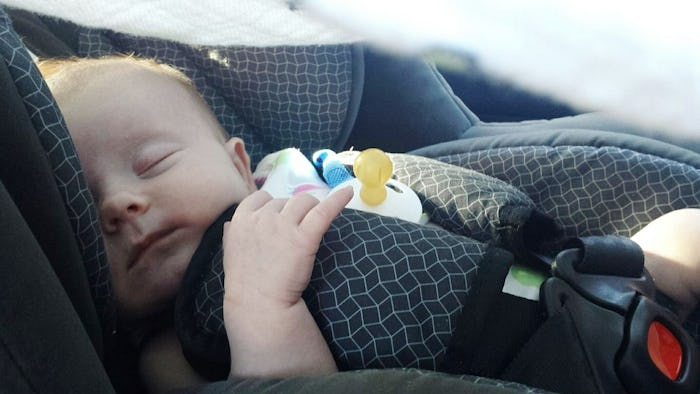Parents are warned about the risks of Sudden Infant Death Syndrome (SIDS) in their prenatal classes, from their OB-GYN, their hospital nurses, and their child's pediatrician. It's a parent's biggest fear, so they put their baby to sleep on the back, avoid smoking, and limit bed-sharing, especially if they've been drinking or taken medication. But, until recently very little was explained to new parents about SIDS car seat risks.
I adored my children's car seat carrier. I actually mourned the day when they outgrew it and had to move into a regular car seat. I loved that I could pop the carrier out of the car and into the stroller in one fell swoop. I loved that my baby always had a comfortable place to sit when we were out. It was a life saver when they started eating solids and I didn't have access to a high chair. But, I must confess, what I loved most was not having to wake up a sleeping baby to get him out of the car.
But, years later, I learned that I may have been putting my kids' lives at risk all along. Here are some SIDS risks for car seats that parents shouldn't ignore.
1Napping In A Car Seat Carrier
I can't tell you the number of times I let my kids nap in the car seat carrier. It never occurred to me to take a sleeping baby out of what seemed to be a safe and comfortable position. They were on their backs, right? In April of 2015, Medical Daily reported that the US Consumer Product Safety Commission (CPSC) and Children's National Medical Center have begun to call attention to the dangers of improperly using infant sitting and carrying devices. The researchers have found that allowing babies to sleep in car seats increases their chances for suffocation, asphyxiation, and entrapment.
WKBN First News 27 in Youngstown, Ohio reported on Cooper Fales, a 3-month-old infant who was found unresponsive in his car seat carrier in 2015 in Michigan. The baby's daycare provider allegedly covered his car seat 10 to 15 minutes before his parents arrived to get him. It was cold, so the father did not uncover the baby until 10 minutes later when he arrived home and found that the baby was stiff and unresponsive. Cooper was pronounced dead at his parent's home, and an investigation revealed that he had died up to two hours prior to being picked up from daycare. The home daycare had no cribs.
According to Wood TV in Grand Rapids, Michigan, the parents have filed a lawsuit against the daycare provider, Teresa Mowers, for breaching her duty to Cooper by "placing him to sleep in his car seat instead of in a crib, by covering his car seat, by failing to monitor him while asleep."
2Covering The Car Seat Carrier With A Blanket
Parents do this for several different reasons: to block out the sun, to protect them from the wind or rain, or simply to avoid strangers coming up to their baby. But this practice can be dangerous as babies are prone to get hot in their car seats and covering the entire seat with a blanket can cause them to overheat, one of the risk factors for SIDS. Seattle pediatrician Dr. Wendy Sue Swanson told Today that it is possible to create a greenhouse effect in an enclosed space, even if you use a muslin cloth or other thin, breathable fabric.
3Using Pillows In The Car Seat
Baby's heads are notoriously falling over in their car seats. Because of this, some parents place little pillows in the car seat to help prop the baby's head up. This is a strict no-no. The baby can bury his nose into the pillow and suffocate. Car Seats For The Littles recommended using thin, tightly rolled receiving blankets alongside (not over the top) of your infant, to give additional support when needed.
4Using After-Market Car Seat Accessories
Car seats are tested using only manufacturer approved accessories. Some companies make "universal" accessories such as strap covers, inserts, or head positioners. Not only can these after-market items change the integrity of the car seat design (which can pose danger in the event of an accident) they can also adjust your baby into an unsafe breathing position. According to the Utah Department of Heath, your baby can be at risk of positional asphyxia, or suffocation, if their body is positioned in a way in which they can't get enough air. It can happen if their nose becomes blocked or if they fall asleep in a position where their chest isn't able to fully expand.
